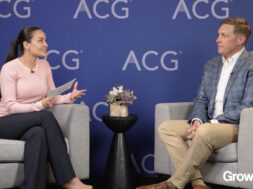Even in a Downturn, Due Diligence Focuses on the Fundamentals
As operating partners shift their focus from growth to operating efficiencies, DealMAX panelists say it’s still a two-sided marketplace

After a period of prioritizing growth in a hot dealmaking environment, today’s challenging macroeconomic climate has middle-market dealmakers shifting their focus during the due diligence phase.
But in lieu of any dramatic changes to how PE firms analyze their investment targets, experts say investors are reinforcing the fundamentals that can pinpoint the healthiest companies in any market condition.
Ahead of their Monday, May 8 DealMAX panel, “Due Diligence in a Downturn,” Brit Yonge, operating partner at Corsair Capital, and Drew Scielzo, operating partner at ACON Investments, spoke with Middle Market Growth to share their take on how to adjust a due diligence strategy amid uncertainty.
The macroeconomic volatility certainly adds complexity to the deal mechanics and deal motion. But fundamentally, you’ve got to ‘get it right.’
Brit Yonge
Corsair capital
“The macroeconomic volatility certainly adds complexity to the deal mechanics and deal motion. But fundamentally, you’ve got to ‘get it right,’” says Yonge, adding, “It’s really about focusing on the fundamentals, and making sure you’re getting your investment thesis right.”
What’s Changed—and What Hasn’t
While the middle market has enjoyed several recent years of accelerated growth resulting in elevated multiples, those years weren’t entirely free from challenges like supply chain disruptions and talent shortages.
Related content: How PE Investors Can Stay Aggressive Amid M&A Slowdown
Today, these pain points may have eased somewhat, but Scielzo says they continue to factor in heavily within the due diligence process. With inflation starting to rise mid-2021 and intensifying through 2022, additional factors have also entered the mix, like a company’s pass-through costs (how businesses adjusted their prices in response to higher operating costs).
But the biggest due diligence shift in recent months, says Scielzo, stems from an overall business environment of slowing growth. As a result, potential acquirers are now assessing a business on its ability to be agile and efficient rather than to expand quickly.
“As growth is slowing, you’re definitely looking at what operational improvements can you make, what costs can you take out to help justify the purchase price you’re going to pay, and the value creation plan,” Scielzo says. “A few years ago, diligence might have been more around growth, and you’re still focused on that, but now there’s more focus on operational improvements that you can make to help justify the returns.”
Two-Sided Marketplace
In this market downturn, much of the M&A conversation has been dominated by declining multiples. Middle-market investment bank Capstone Partners recently released data that found multiples for M&A transactions below $500 million fell from 10.7x in 2021 to 9.9x in 2022.
The trend may yield assumptions that buyers hold the leverage in the dealmaking process as sellers are willing to settle for lower valuations. But even in industries experiencing particularly intense volatility today, like the technology sector, businesses in the middle market remain resilient.
Yonge, who specializes in technology, software and data analytics, says that the Twitters of the world certainly are facing immense disruption. But in the middle market, “it’s still a two-sided marketplace,” he says. “These are still great companies, and they’re companies that someone wants to own.”
Price fluctuations are merely the nature of the dealmaking marketplace, adds Yonge. So even if a business might not achieve the kind of multiples seen in 2021, owner-operators are assessing potential acquirers just as much as acquirers are assessing their acquisition targets.
What changes based on the economic environment is what the value creation plan is. Making sure that (the management team) can execute upon it, making sure their skill set is aligned—that’s first and foremost.
Drew Scielzo
ACON Investments
A Relationship-Focused Process
Both Yonge and Scielzo agree that middle-market M&A is a matchmaking process that not only involves assessing whether each side is the right financial fit for each other, but exploring how the people entering into a deal can collaborate.
Regardless of how the market is performing, acquirers must go beyond financial statements and assess how owner-operators and their management teams can execute on value creation plans that investors and businesses develop together.
“That’s always first and foremost, and that runs across all different economic environments,” says Scielzo. “What changes based on the economic environment is what the value creation plan is. Making sure that (the management team) can execute upon it, making sure their skill set is aligned—that’s first and foremost.”
Related content: How to Network Like a Pro at DealMAX (or Any Conference)
Retaining the human element of the M&A process can help potential acquirers keep things in perspective in a market downturn, notes Yonge. Yes, volatility and uncertainty can weigh on a company’s outlook. But in the middle market, business founders and leaders are working every day to meet customer needs and improve their offerings. Their success in those pursuits and an investor’s ability to support those efforts are what’s under the microscope during the due diligence process, in any macroeconomic climate.
“You’re having to underwrite someone’s hopes and dreams and ambitions,” says Yonge. “It’s fun to be at the nexus of that in this deal process, when both sides are learning about each other and figuring out what’s next for everyone.”
Carolyn Vallejo is Middle Market Growth’s digital editor.


